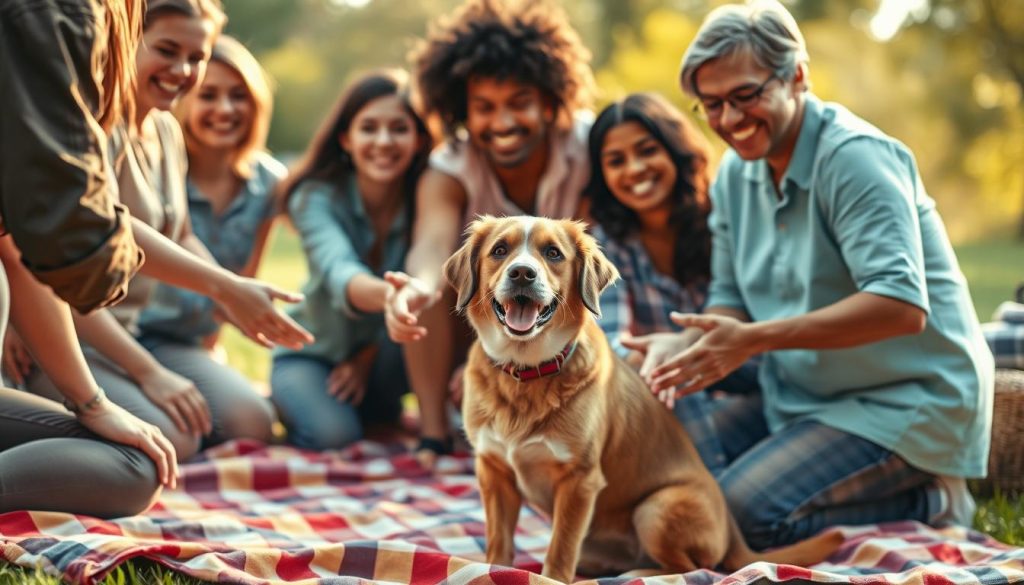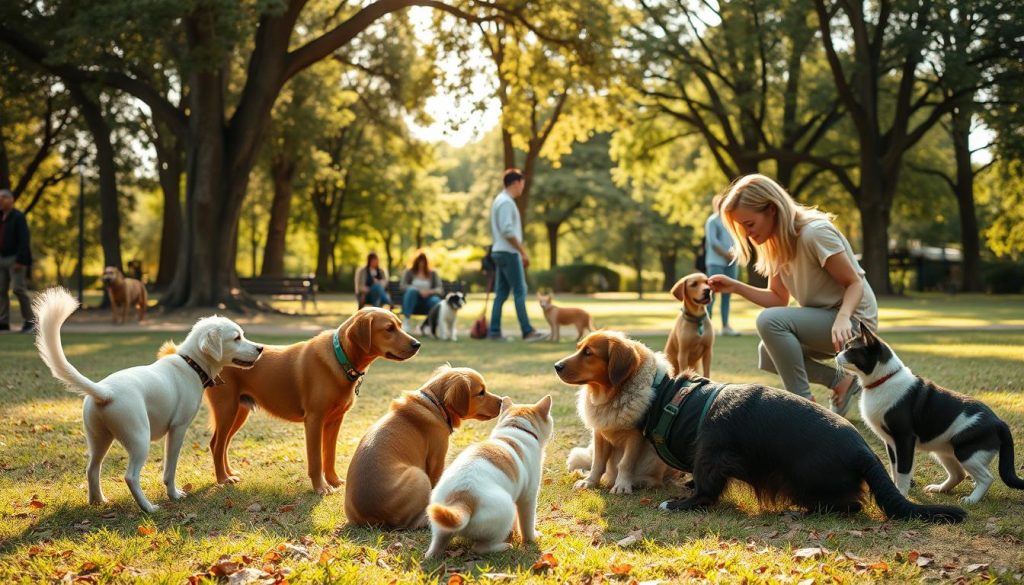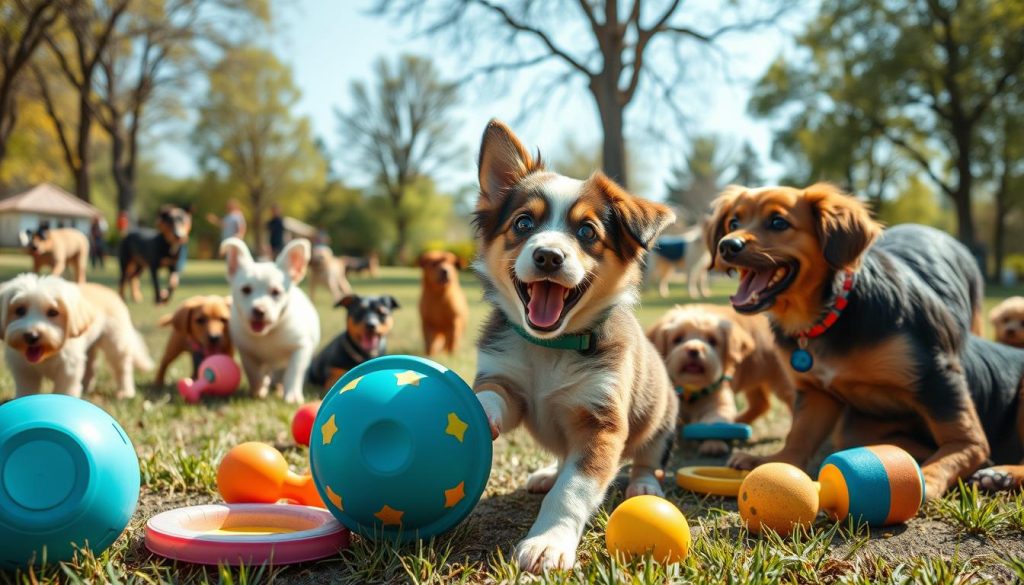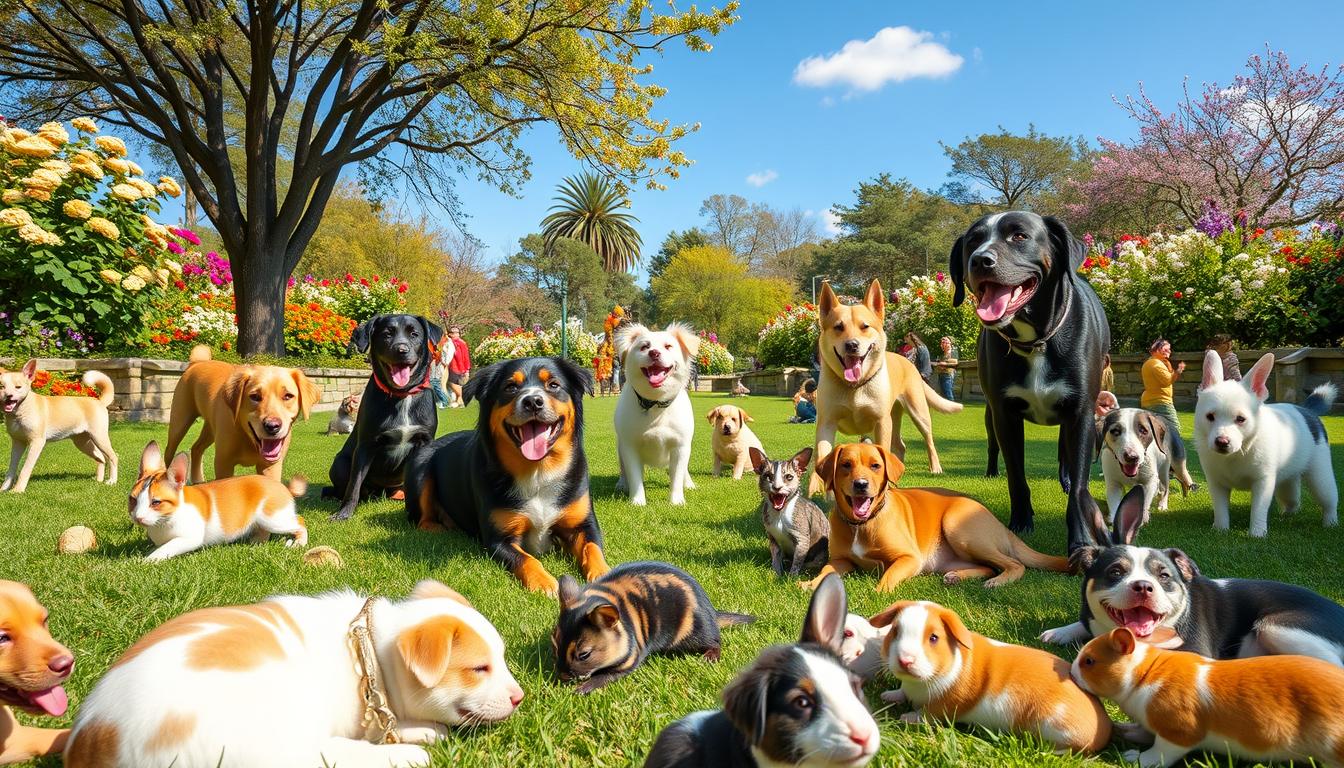As a pet owner, I understand how crucial it is for my furry friends to feel at ease in social settings. is vital for their happiness and adjustment. In this article, I’ll share useful tips for pet socialization to ensure your pets’ success.
Proper is essential for a lifetime of positive experiences. It helps them develop social skills for thriving. Whether you have a playful pup or a curious kitten, these strategies will make your pet confident and well-socialized.
This guide will cover the importance of socialization, creating positive experiences, and overcoming challenges. By the end, you’ll have the tools to make your happy, secure, and ready to explore the world with you.
Understanding the Importance of Pet Socialization
Socializing your pet is key to their happiness and growth. It makes them more confident and less likely to have behavioral problems. By introducing them to new things, people, and animals, you help them avoid fear and aggression.
Why Socialization Matters for Your Pet’s Well-Being
Socialization shapes your pet’s personality and behavior. Well-socialized pets are calm, friendly, and easier to train. They handle new situations and people better, without getting anxious.
The Benefits of a Well-Socialized Pet
- Increased confidence and adaptability
- Reduced risk of developing behavioral issues, such as fear, anxiety, or aggression
- Easier to train and integrate into different social settings
- More enjoyable and enriching interactions with their human family and other pets
| Benefit | Description |
|---|---|
| Confidence and Adaptability | Well-socialized pets are more confident and adaptable, able to handle new situations and environments without becoming overly stressed or fearful. |
| Reduced Behavioral Issues | Proper socialization helps prevent the development of behavior problems, such as fear, anxiety, and aggression, which can be challenging to address later in a pet’s life. |
| Easier Training | Socialized pets are generally more receptive to training and can learn commands and behaviors more easily, enhancing the bond with their human family. |
| Enriched Interactions | Well-socialized pets are able to engage in more enjoyable and enriching interactions with their human family and other pets, leading to a happier and more fulfilling life. |
Introducing Your Pet to New People and Animals

Socializing your pet is key for their happiness and well-being. It’s important to introduce them to new people and animals in a positive way. This helps them feel comfortable and confident around others. I’ll share some tips to make these introductions stress-free and positive.
When meeting new people, start by having them offer a treat or gently pet your pet while you’re there. This helps your pet see the new person as a positive experience. Don’t push them to interact too much – let them set the pace.
- Introduce your pet to new people slowly and in a calm, controlled environment.
- Have the person offer a treat or gently pet your pet while you are present.
- Never force interactions or overwhelm your pet – let them approach the new person at their own pace.
When introducing your pet to other animals, choose a neutral, safe place. Start by introducing them slowly, watching their body language and how they interact. Positive reinforcement, like treats and praise, helps them associate with the new animal positively.
- Introduce your pet to other animals in a neutral, safe space.
- Supervise the interactions closely and watch for signs of stress or discomfort.
- Use positive reinforcement, like treats and praise, to create a positive association.
Pet socialization is a slow process. It’s important to go at a pace that makes your pet comfortable. With patience and the right techniques, your pet can become a confident and well-adjusted friend.
Creating Positive Socialization Experiences
Positive pet socialization is key to raising confident, well-adjusted pets. It’s important to set the stage for success and use positive reinforcement to encourage good behavior.
Setting the Stage for Success
When introducing your pet to new people, animals, or places, manage the situation carefully. Start by slowly introducing them to new things, letting them go at their own pace. Make sure they have a safe, familiar spot and offer their favorite treats or toys to make the experience enjoyable.
Reinforcing Good Behavior with Positive Reinforcement
Positive reinforcement is a great way to encourage good behavior in pets. When your pet acts calm, friendly, or curious, reward them right away with praise, affection, or a treat. This positive feedback helps them learn and repeat those good behaviors.
By creating a positive, stress-free environment and using positive reinforcement, you help your pet become more confident in social situations. This leads to a happier pet and a stronger bond between you and your furry friend.
| Technique | Description | Benefits |
|---|---|---|
| Gradual Exposure | Slowly introducing your pet to new people, animals, or environments at their own pace | Reduces stress, builds confidence, and helps your pet feel safe and comfortable |
| Positive Reinforcement | Rewarding your pet with treats, praise, or affection for calm, friendly behaviors | Reinforces desirable behaviors, increases your pet’s willingness to engage, and strengthens the bond between you |
Pet socialization tips: Gradual and Controlled Exposure

When socializing your pet, it’s important to do it slowly and carefully. Too much, too fast can make them scared or anxious. I’ll give you tips on how to introduce them to new people, animals, and places safely.
It’s all about going at your pet’s pace. Begin with new things in a place they feel safe, like home or a familiar park. Let them get used to it at their own speed, and always praise them for being brave.
- Get your pet used to new sights, sounds, and smells little by little. Introduce one new thing at a time and be patient.
- Use treats and praise to make new things positive for them. This builds their confidence and trust.
- Meet new people and animals in a safe, controlled way. Make sure they have a place to go if they feel overwhelmed.
- Watch how your pet acts and reacts. If they seem scared or stressed, take them out of it and try again later.
Every pet is different, and they need different things when it comes to socializing. By going slow and careful, you can help your pet become a happy, confident friend.
| Gradual Pet Socialization | Controlled Pet Socialization |
|---|---|
| Introducing new experiences slowly and steadily | Maintaining a safe, comfortable environment for your pet |
| Allowing your pet to acclimate at their own pace | Observing your pet’s body language and cues |
| Using positive reinforcement to build trust and confidence | Removing your pet from stressful situations as needed |
Socialization Throughout Your Pet’s Life Stages

Socialization is a lifelong process. The approach changes based on your pet’s age and life stage. As a responsible pet owner, it’s key to socialize your furry friend at every stage. This ensures they stay well-adjusted and confident.
Puppy and Kitten Socialization Basics
The early months of a pet’s life are crucial for socialization. Puppies and kittens learn fast, soaking up new experiences. It’s the best time to introduce them to various people, animals, sights, sounds, and environments in a positive way.
- Expose your puppy or kitten to different people, from young children to the elderly, in a calm and friendly setting.
- Introduce your pet to other well-socialized animals, such as dogs or cats, to help them learn appropriate play and social behaviors.
- Accustom your pet to different surfaces, textures, and noises, like the vacuum cleaner or the sound of a car passing by.
By providing these enriching experiences early on, you’ll create a well-rounded, adaptable pet. They’ll be confident and comfortable in many situations throughout their life.
Remember, socialization is an ongoing process as your pet grows. Keep introducing them to new experiences and reinforce positive behaviors. With patience and consistency, you can keep your pet’s socialization a priority for their whole life.
Overcoming Socialization Challenges and Setbacks
Even the most dedicated pet owners can face socialization challenges and setbacks with their furry companions. But don’t worry, I’m here to guide you through the process of troubleshooting and overcoming these obstacles. Whether your pet is struggling with fear, anxiety, or aggression, I’ll provide practical strategies to get them back on the path to becoming a well-adjusted and confident companion.
One of the keys to overcoming socialization issues is to identify the root cause. Is your pet fearful of certain people or animals? Are they exhibiting signs of anxiety, such as excessive barking or hiding? By understanding the underlying reason for their behavior, we can develop a customized plan to address it. Remember, patience and positive reinforcement are essential when working through socialization setbacks.
Additionally, I’ll share tips on how to gradually and safely reintroduce your pet to the situations that trigger their challenges. Slow, controlled exposure, combined with plenty of praise and treats, can help your pet build confidence and overcome their fears. With consistent practice and a little creativity, I’m confident we can find a solution that works for both you and your furry friend.

